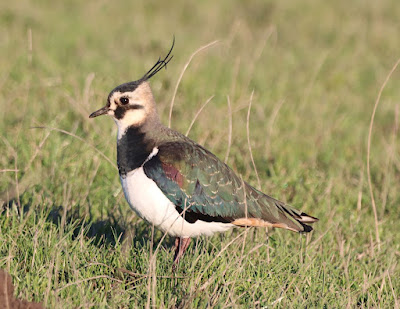All through October and November we looked, listened and waited for Fieldfares to arrive in the west when their size, colour and loud chuckling voices would send our eyes skywards in appreciative glances.
The Fieldfare is not a species a wide awake birder can miss when the thrushes make it from Norway in their dozens, hundreds, even thousands and drop into glowing-red hawthorn hedgerows to then feast like there’s no tomorrow.
Fieldfare
Maybe the constant wind and rain of autumn here in the west persuaded many to remain in the North East and then travel quickly south towards France and Spain rather than cross the backbone of England to warm wet Lancashire?
Whatever the reason for the deficiency of recent weeks it was more than good to catch up with a small number of Fieldfares out Cockerham last week when the sun shone bright and Fieldfares looked their best. But for this interlude it might be February, March or April before Fieldfares make another appearance, this time on their way back to Northern Europe.
In the days of the last century, before even me, the thrush we now call Fieldfare was known as Bluebird to distinguish it from its allies the Mistle Thrush, then named Greybird, and the accurately named Blackbird.
As I focused on the Fieldfare’s multifaceted colours and clicked the button, I thought that Varied Thrush - The Haunting Voice of Ancient Forests, might be a more suitable name but posting pictures on the Internet of a Varied Thrush at Cockerham might cause a stampede through the narrow lanes. For sure any such mistake, deliberate or otherwise, would upset local farmers and not help my notoriety among local birders.
Near the top of the hawthorns up popped the ultimate rarity, a shyster; but no, not a politician, the timid, unsure, and now impossible to find Song Thrush. I couldn’t remember the last time I saw one, let alone a half chance at a picture, a species now hardly ever reported by local birders.
It’s too late to rescue the British Song Thrush. We rip out hedgerows and blanket the countryside in concrete and white elephant windmills where Song Thrushes can’t live; but no one cares. Follow The Money.
The few Blackbirds around proved harder to picture than gregarious Fieldfares. The Fieldfares might sit there motionless for a minute, eyeing up a bunch of berries until they decided to eat while the Blackbirds stole through the black branches nicking a berry or two if they thought no one was looking.
Blackbird
Fieldfare
Blackbird
I drove back through Pilling where roadside Lapwings, Golden Plovers and Curlews provided a background symphony of wild calls to the thrum of traffic going nowhere while seeing nothing.
It’s always Lapwing to the fore, Curlews a little further away and Golden Plovers way back, 100 yards or more, out of sight out of mind, except to shooters. Yes in 2023, Golden Plovers are Schedule 2 species, which means that it is legal to shoot them outside the closed season and a feather in a shooter's cap to bag one.
No one cares. Follow The Money.
























.jpg)













12 comments:
Hello Phil,
Beautiful birds, your photos are a treat. I love the Fieldfare, the Lapwing and the Curlew. The Plover is a cutie! Take care, have a wonderful week!
Beautiful shots, Phil! I love seeing your birds, so different from ours.
Thank you for sharing at http://image-in-ing.blogspot.com/2023/12/a-living-nativity-at-nearby-church.html
I love to see your birds, Phil, so different from ours!
Thank you for sharing at http://image-in-ing.blogspot.com/2023/12/a-living-nativity-at-nearby-church.html
I'm not familiar with your birds, but always love your photos. Each is a beauty in its own way.
You got some lovely pics - the lapwing is crazy looking. Love it! #WWOT
Great captures, Phil!
Your bird photography is stunning and it's fascinating to see the diversity compared to the birds in our area.
Happy Tuesday!
Lovely captures of the cuties.
Congratulations on the Song Thrush. It's story of decline is becoming all-too-familiar for some species around the planet.
It's good the Fieldfares took pity and gave you a chance to see them before flitting off on their winter vacation. That's an interesting bit on why they were once called Bluebirds.
The contrast of Blackbirds among red Hawthorns is really pleasing.
In our area, a Golden Plover would be near-headline news. Hard to think about them as "game birds".
All is good around these parts. Gini is gathering mountains of supplies for baking breads, cakes and cookies for the upcoming Yuletide extravaganza. Number One Grandson is scheduled to make an appearance from the far northeast so we're looking forward to that.
We hope you and Sue are surviving the onslaught of capitalism and will have a tuppence or two left over for a helping of plum pudding.
I care, but I have no money.
I have never seen a Fieldfare, and in almost 20 years here I have only spotted one Mistle Thrush. I have rarely seen Lapwings but they do seem to pass through at certain times of the year. At the moment we have noisy skies as the Cranes are all heading South and we are lucky enough to live under their flight path.
I hope that all is well, I wish you all the best for Christmas and 2024, cheers Diane
Many thanks for the lovely photographs here Phil, a very good variety.
Hope your December days are going well, Christmas will soon be here :)
All the best Jan
Belated Happy Christmas and all the best for 2034. Cheers Diane
The song thrush used to be a common visitor to the garden but not any more. I can't remember the last time I saw one..
Post a Comment